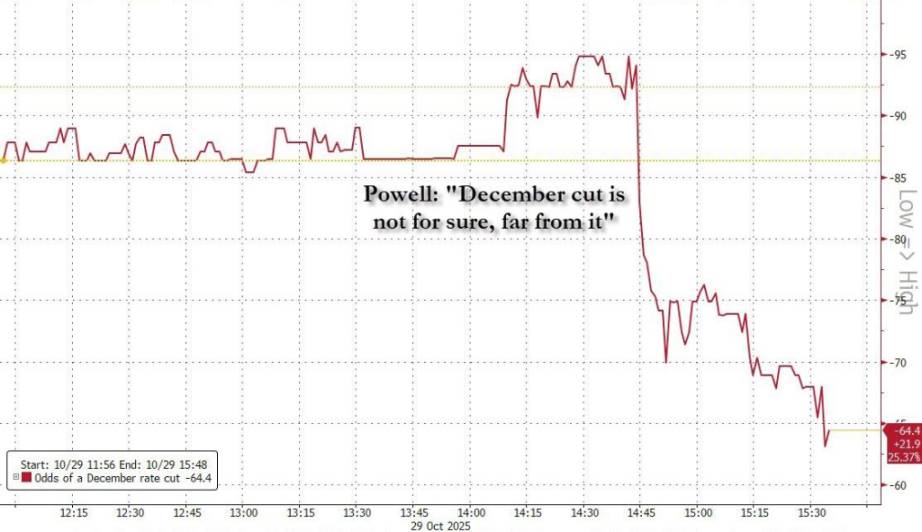The path of future monetary policy is filled with high uncertainty, and the easiest part of this round of easing may have already ended.
Written by: Ye Zhen
Source: Wall Street Watch
The Federal Reserve lowered interest rates as expected, but Powell's hawkish signals at the post-meeting press conference doused the market's widespread expectations for another rate cut before the end of the year.
Nick Timiraos, a reporter for the Wall Street Journal known as the "new Fed whisperer," stated in a recent article that Powell's unusually tough stance not only highlights the increasing divisions within the FOMC but also indicates that the path of future monetary policy is fraught with high uncertainty against the backdrop of "blind flying" economic data.
On Wednesday local time, the Federal Reserve announced a 25 basis point cut in the benchmark interest rate, lowering the federal funds rate target range to 3.75% to 4%, the lowest level in three years, marking the second consecutive meeting of rate cuts. However, the focus of the press conference quickly shifted to Powell's views on future policy. He explicitly refuted the market's belief that a rate cut in December was a "done deal," stating that this prospect was "far from certain."
Powell's remarks had an immediate effect, reversing the market's optimistic sentiment, with the probability of a December rate cut plummeting from 95% to 65%. The Dow Jones Industrial Average and the S&P 500 erased their intraday gains, with the Dow closing down 0.2% and the S&P 500 slightly lower. The 2-year U.S. Treasury yield, which is most sensitive to interest rate expectations, surged by 0.092 percentage points to 3.585%, marking the largest single-day increase since early July.

Timiraos analyzed that Powell's speech clearly indicated that as "more and more officials" question the necessity of further rate cuts, the easiest part of this round of easing may have already ended. Meanwhile, with each rate cut, the question of when to stop cutting rates has become increasingly urgent.
Internal Divisions Emerge, Decision Voting "Three-Way Split"
The latest interest rate decision passed with a vote of 10 in favor and 2 against, revealing serious divisions within the committee. Kansas City Fed President Jeffrey Schmid cast a dissenting vote, preferring to keep rates unchanged; while Fed Governor Stephen Miran held a different view, advocating for a larger cut of 50 basis points.
This "three-way split" voting pattern confirms Powell's assertion that there are "strongly differing views" within the committee. Powell acknowledged at the press conference that there is a "growing chorus" among decision-makers who are skeptical about the need for further easing.
Although a slight majority of officials in the September economic forecast expected two more rate cuts this year, leading the market to lean towards a higher likelihood of a December cut, a considerable number of officials at that time believed that no further action should be taken after the September cut. These officials were more concerned about inflation issues—over the past few years, inflation rates have consistently exceeded the Fed's 2% target and have stopped declining this year, partly due to tariffs imposed by Trump that raised commodity prices.
Powell's tough stance surprised the market, which had highly anticipated a December rate cut, leading to divergent views among analysts regarding the subsequent path.
Vincent Reinhart, chief economist at BNY Mellon Investment Management and former senior advisor to the Fed, believes that given the data vacuum, "the data must prove that further easing is unreasonable, which is a high bar," adding that "it would be very difficult for them (the Fed) not to cut rates in December. Continuing is easier than stopping."
However, James Bullard, dean of Purdue University's business school and former president of the St. Louis Fed, believes that the prospects for a December rate cut are "more nuanced than the market currently thinks." He pointed out that strong consumer spending and economic growth, coupled with recent inflation setbacks, could provide reasons to slow the pace of rate cuts. "You are betting too much on a slowdown in non-farm payroll reports," Bullard said. He also questioned whether policymakers have truly adapted to the new normal where adding 50,000 jobs per month is "perfectly acceptable."
Government Shutdown Leads to Data "Blind Flying," Increasing Uncertainty and Difficulty in Rate Cuts
What makes decision-making more challenging is the economic data vacuum caused by the government shutdown. Powell pointed out that if the lack of data leads officials to face "very high uncertainty" about the economic outlook, this alone could serve as a reason to "support cautious action."
Typically, economic reports between meetings help bridge the divisions among officials. However, the absence of key labor market indicators has left them without the information needed to resolve their differences.
Timiraos' article cites William English, a professor at Yale School of Management and former senior advisor to the Fed, stating that the lack of data means "they haven't learned much since September, which makes their positions likely similar to those in September, but the range of uncertainty around that is much wider."
In this regard, Wall Street Watch previously mentioned that Bank of America has outlined several possible scenarios:
Scenario 1: If the government reopens before the end of November, the market could see an "outdated" September employment report before the December meeting. A weak report could reduce the risk of hawkish opposition, but even if the data is strong, it may be difficult to persuade Powell to pause rate cuts due to its "outdated" nature.
Scenario 2: If the government ends the shutdown in early November, allowing the Bureau of Labor Statistics to release both September and October reports before the meeting. In this case, if the unemployment rate remains stable and economic activity is robust, then a "pause in rate cuts" in December would become a real option.
Scenario 3: In the best-case scenario, if the government quickly reopens and the Bureau of Labor Statistics releases all three employment reports for September, October, and November before the meeting. Bank of America proposed a decision "rule of thumb": if the November unemployment rate is at or below 4.3%, the Fed may hold steady; if it is at or above 4.5%, it would prompt a rate cut; if the unemployment rate is 4.4%, the decision would be a "close call."
Balancing Inflation Concerns and Employment Slowdown
Timiraos' article points out that currently, the core of the Fed's policy debate is how to balance controlling inflation with addressing economic slowdown. On one hand, some officials do not want to over-cut rates to avoid overheating the economy, which could lead to inflation remaining persistently above target. The recent stock market highs driven by rate cut expectations have also increased their concerns about financial stability.
On the other hand, other officials worry that the impacts of changes in trade policy and the lagging effects of past rate hikes on interest-sensitive sectors like housing should not be overlooked, as these factors are squeezing spending from low-income consumers and small businesses. In recent weeks, several large employers in the U.S. have announced plans to cut white-collar jobs.
The labor market is at the center of this debate. Although inflation readings appear somewhat resilient, the labor reports from this summer show a sharp slowdown in job growth, prompting the Fed to return to a rate-cutting path. Data shows that in the three months ending in August, the average monthly job growth was about 29,000, far below the 82,000 from the same period last year. Policymakers are trying to clarify whether the slowdown in job growth is due to a decrease in the number of people entering the U.S. job market or a decline in labor demand.
Timiraos states that without clear data showing a substantial deterioration in the labor market, it is difficult to garner enough support for a rate cut exceeding 25 basis points. Meanwhile, with each rate cut, the question of when to stop cutting rates has become increasingly urgent.
免责声明:本文章仅代表作者个人观点,不代表本平台的立场和观点。本文章仅供信息分享,不构成对任何人的任何投资建议。用户与作者之间的任何争议,与本平台无关。如网页中刊载的文章或图片涉及侵权,请提供相关的权利证明和身份证明发送邮件到support@aicoin.com,本平台相关工作人员将会进行核查。




